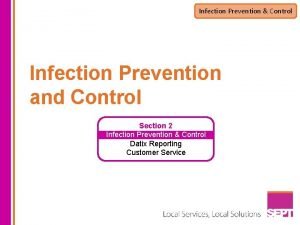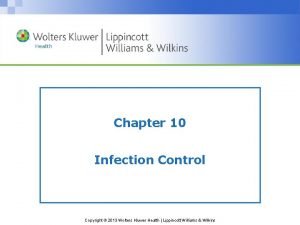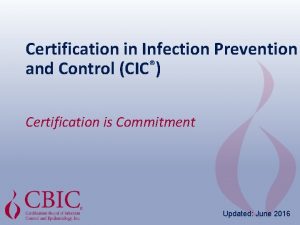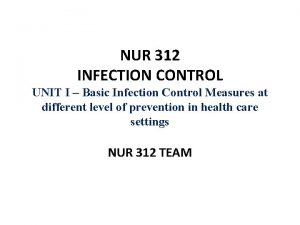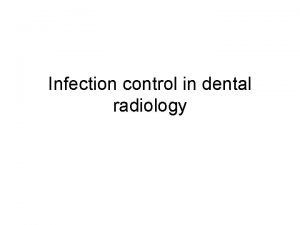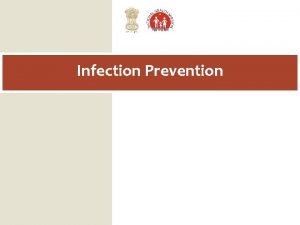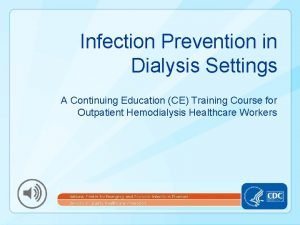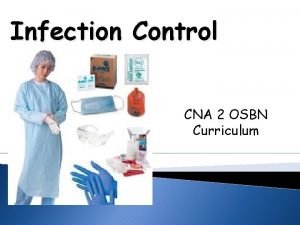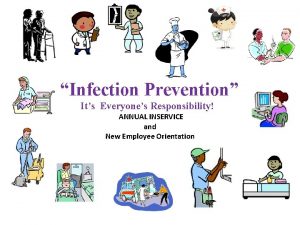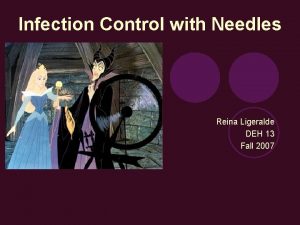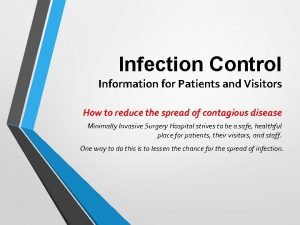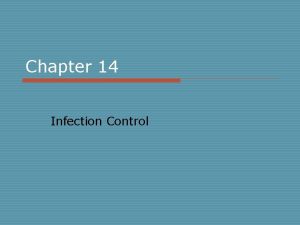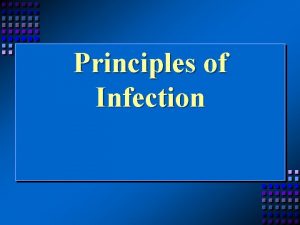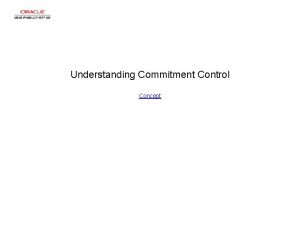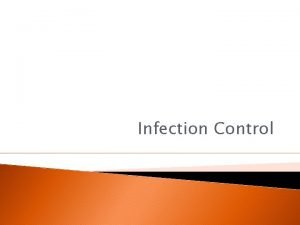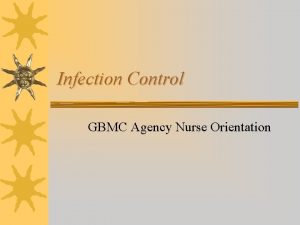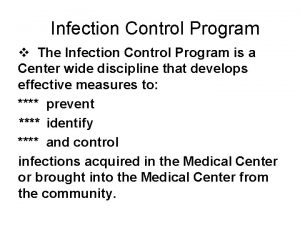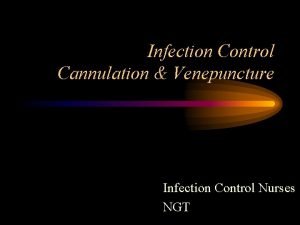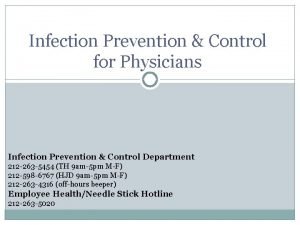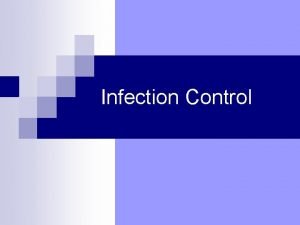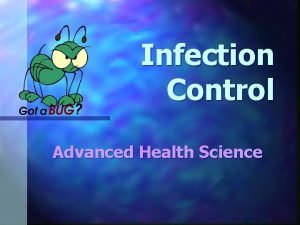Chapter 14 Infection Control Understanding Principles of Infection


















- Slides: 18

Chapter 14 Infection Control

Understanding Principles of Infection Control o o o Microorganism Pathogens Nonpathogens Aerobic Anaerobic

Virus vs. Bacteria o Bacteria n n n o Cocci Bacilli Spirilla Viruses n n Smallest microorganisms H 1 N 1 HIV (AIDS) Hepatitis

Types of Infection o o Nosocomial (acquired in health facility) Endogenous (originates inside body) Exogenous (originates outside body) Opportunistic (body defenses are weak)

Chain of Infection o o o Causitive Agent (pathogen) Reservoir (where pathogen lives) Portal of Exit (way for pathogen to escape) Mode of Transmission (the way the pathogen is transmitted) Portal of Entry (a way the pathogen enters a new reservoir) Susceptible host (person likely to get an infection)

Aseptic Techniques o Asepsis – absence of disease-producing organisms o Sterile – free from ALL organisms Contaminated – organisms and pathogens are o Antisepsis – prevent or inhibit growth of o o o present pathogens but NOT effective against spores and viruses Disinfection – process that destroys or kills pathogenic organisms but not always effective against spores and viruses. Sterilization – destroys ALL microorganisms

Hand Hygiene o o MOST IMPORTANT METHOD USED TO PRACTICE ASEPTIC TECHNIQUE See pg 360: When to wash hands

How to Wash Hands o o o o pg. 360 Soap Warm water Friction Clean all surfaces Fingertips pointed downward Dry paper towels used to turn off faucet

Bloodborne Pathogens Standard o Pathogens of major concern: n n n o HBV HCV HIV In 1991 OSHA established Bloodborne Pathogen standards that must be followed by ALL health care facilities (pg. 363)

Standard Precautions o o o Rules developed by CDC Every body fluid must be considered a potentially infectious material All patiens are considered potential sources of infection

When to use Standard Precautions o Whenever potential contact with: n blood or any fluid that may contain blood n Body fluids, secretions and excretions o o o o o Mucus Sputum Saliva CSF Feces Urine Vomitus Semen Vaginal secretions Pericardial, synovial, pleural, peritoneal fluids

Basic Rules o o o o o Handwashing Gloves Gowns Maskes and eye protection Sharps Spills or splashes Resuscitation devices Waste and linen disposal Injuries

Sterilizing o Autoclave = uses steam under pressure or gas to sterilize equipment and supplies

Chemical Disinfection o o o Used for aseptic control Many chemicals do NOT kill spores and viruses Used to disinfect instruments that do not penetrate body tissue (dental instruments, scissors)

Ultrasonic Unit o o o Cleans using sound waves Removes dirt, debris, blood, saliva and tissue from instruments prior to sterilizing NOT sterilization because does not kill all spores and viruses

Using Sterile Technique o o o Sterile = free from all organisms Contaminated = organisms and pathogens are present Sterile Field n n n 2 in border Never reach across Keep in constant view

Maintaining Transmission Based Isolation Precautions o o o Communicable Disease = pathogen that is easily transmitted Epidemic = when communicable disease spreads rapidly from person to person and affects large number of people at the same time. Pandemic = outbreak occurs over wide geographical area.

Transmission Based Isolation Precautions o Method or technique of caring for patients who have communicable diseases n n o o o Tuberculosis Pertussis Standard Precautions Airborne Precautions Droplet Precautions Contact Precautions Protective or Reverse Isolation
 Quats cosmetology
Quats cosmetology 10 principles of infection control
10 principles of infection control Chapter 16 infection prevention and control
Chapter 16 infection prevention and control Chapter 16 infection control and standard precautions
Chapter 16 infection control and standard precautions Chapter 15 infection control
Chapter 15 infection control Chapter 15:7 cleaning with an ultrasonic unit
Chapter 15:7 cleaning with an ultrasonic unit Chapter 10 infection control
Chapter 10 infection control Dental radiology ppt
Dental radiology ppt Cic certification infection control
Cic certification infection control Infection control meaning
Infection control meaning Darkroom infection control guidelines
Darkroom infection control guidelines Learning objectives for infection control
Learning objectives for infection control Conclusion of infection
Conclusion of infection Cna infection control
Cna infection control Certification board of infection control and epidemiology
Certification board of infection control and epidemiology Infection control is everyone's responsibility
Infection control is everyone's responsibility Infection control
Infection control Tier 1 standard precautions
Tier 1 standard precautions Infection control information
Infection control information

